
Atlas F1 Technical Writer
Following their worst season in decades, the McLaren team aim to return to the top with a new car which promises to have all the right elements to carry over the momentum built up in the last half of 2004. Atlas F1's Technical Writer Craig Scarborough offers a full analysis of the changes and features found on the new MP4-20
Not since the original twin keeled MP4-17 in 2002 have McLaren formally launched a new car. Since then the 17 evolved into the 17D while the MP4-18 project stumbled on, with the MP4-19 appearing early last year only to be revised into the MP4-19B. While 2003 was initially a more competitive year, McLaren's era of dominance waned as the new car projects faltered and the new cars suffered for pace or reliability. Martin Whitmarsh pointed out "the MP4-18 and MP4-19A were not illustrious periods in the history of McLaren"; while the results of these problems manifested themselves as technical failures, the root cause was pinpointed as a management problem.
Asking McLaren's Managing Director Martin Whitmarsh about the changes brought about this year as a result of the team's recent history, in typical McLaren fashion the reply was long and comprehensive: "I think the changes that we made during the course of the year were part technical and part approach or process. We worked hard during the course of last year to make sure the organisation was clearly focussed on our goals. We had three locations; one in Woking, one in Brixworth and one in Stuttgart. Early last year we came to the conclusion we didn't have quite the appropriate common focus between those organisations; since then we've changed the engine organisation significantly.
"During the course of last year we made good and positive progress on the engine side of the programme. That's all been consolidated, and now we have new MD at Mercedes-Ilmor; Ola Kaellenius. I think he will do an extremely competent job; Ola will continue to work very closely with me, and has been involved with McLaren for over two and half years, albeit on the road car side." So with the management structure in place and the organisations working cohesively it was then the technical issues that were addressed.
Since the MP4-18 project started McLaren had some very different priorities to most Formula One teams in the car's design. McLaren's immense resources allowed Newey to focus more on the structure of the car, making it much lighter and stiffer and working with the weight distribution. This emphasis partly led to the failings with the MP4-18; the car was too light to be durable and suffered many failures, including the carbon fibre gearbox. The team also followed some left field aerodynamic directions by retaining the twin keel and attaching the front wing in a different manner; the exhausts were also again routed into the diffuser rather than out the top of the sidepods, and the sidepod packaging left insufficient cooling.
But by the time the team were ready to discard these directions and get back on a more conventional track they were already behind the opposition with an outdated car and data. This process started with the MP4-18B, and evolved with the new rules changes into the MP4-19. Martin Whitmarsh detailed the process McLaren went through: "in the course of last year we set about an ambitious programme to address the deficiencies we felt in the MP4-19A. We did what were able within the confines of the MP4-19A and formed the MP4-19B, which I believed was a relatively competitive car at the end of the year.
"Technically within the project itself, I think we have really readdressed some of our priorities; clearly the most obvious purpose of any design team is to reduce drag and increase downforce, but you can't do that at the cost of aerodynamic sensitivity to ride height changes, pitch or yaw. Also, in pursuing such goals you can sometimes not give sufficient attention to issues of stiffness or compliance; there's a fine balance. If you seek to make a car which has a very limited compliance you can do so at the cost of aerodynamic performance, and therefore you have to make sure the balance right. We learnt some good lessons from the analysis of the MP4-19A, we did what we able to in addressing some of those issues in the MP4-19B, and have been able to take a step further on the MP4-20."
Having taken stock of the failings in the MP4-20's predecessors McLaren have adopted almost a conservative approach. The new car is a clear progression from the MP4-19B, optimising some of the temporary solutions installed on that car and bringing some new solutions adapted from other teams. In detail the car does not feature any major innovations, but its design does appear to be more well-balanced than its forebears. Whitmarsh is more confident in the new car than some of the views expressed by the team when releasing their new car last year. This new confidence was partly shown through the limited press launch of the MP4-20, with Whitmarsh confirming "I think the MP4-20 is going to be a decent step forward on the MP4-19B."
Aerodynamics
"I think Nick has very quickly earned the respect of his fellow engineers, and has brought structure and discipline to the aerodynamic processes within the company, which has been very beneficial, and he has ensured the aerodynamic goals have not been to the detriment of the other objectives in the programme. He has added to the strength of the engineering and aerodynamic culture of the company. With Adrian as technical director, who is also very much a contributing aerodynamicist, then Peter Promodrou as Head of aerodynamics and Nick Tombazis we have three of the strongest aerodynamicists in the business."
With the aim of running the new car in Melbourne, the layout of the launch car has to be pretty close to the format to be used in Australia. At the car's first running at Valencia the car sported a 3-element front wing set up that was similar to that run last year, albeit mounted 50mm higher as demanded by the rules. Allied to the raised wing was a similar wide nose arrangement as that debuted after the B spec was raced; this wider nose droops down over the front wing with its underside as wide as the space between the twin keels which, along with the bargeboard arrangement, are another carry over from the MP4-19B.
Where the bargeboards meet the sidepods the new directions start to appear. The sidepods are now much more undercut, along the lines of the new Sauber, but unlike that car the McLaren sidepod inlets are triangular in section, not square, and hence are not as blended with the chassis above the shadow plate. Making this undercut work is a totally new floor arrangement taking hints from last years Williams, with a floor fin jutting out from the outer edge of the sidepod. The inner edge is curved to meet the curved flow routing around the sidepods and route over the floor; any air caught under this fin is flicked up by a rounded trailing edge. In fact this whole area is filled with aero devices to manage the flow and prevent it spilling under the floor, ensuring the lowered diffuser can work to its best. As a result the foot plate running along the main bargeboard joins the floor fin, and another fin sprouts from the shadow plate.
Within the sidepods compound-angled radiators are installed to allow the tight packaging of the undercut and the tightly waisted coke bottle area. While McLaren's sidepods from the MP4-18 to the MP4-19B have been slim, they have always struggled with cooling and burning bodywork; this car has had more forethought put into its cooling outlets, with chimneys installed on large detachable panels, allowing for a Sauber-like grill outlet directly above the radiators. Behind these panels are another set of outlets moulded into the exhaust fairings.
Inboard of the exhaust, the sidepods are raised to provide an opening allied to the bodywork, dropping into the duct from behind. The exhaust panel is also oversized, allowing for different panels with similarly arranged openings to those cut out of the main bodywork last year. Again McLaren run long secondary exhausts protruding way out of the fairing. Curiously, McLaren have adopted the curved chimneys pioneered by Renault, but have installed no winglets behind them; when the chimneys work well in conjunction with winglets, and while there is a convenient space left on the sidepods to mount them, it isn't understood why these are not present on the car.
As for the diffuser itself McLaren have followed the stepped approach, making the first section of the diffuser as steep as possible to aggressively pull the air from under the floor. The area around the wheels makes do with simple fences to reduce the effect of the enforced gap around the wheels.
Lastly the cockpit and roll structure have been refined. As has been the case with the other recent McLarens, the chassis ahead of the cockpit is raised an inch or so, with the step between the raised scuttle and cockpit (at a height fixed in the rules) has been blended neatly either side of the opening. The sidepods appear higher at their fronts, with the cockpit side padding blending very neatly into the sidepod tops, leaving the fuel flaps perfectly horizontal. The cockpit side padding is wider this year, and while most teams a have narrowed this as much as possible towards the steering wheel, Adrian Newey has kept a wider pad, making the narrowest possible cockpit opening, and simply leaving the driver's helmet and steering wheel exposed.
With the departure of David Coulthard McLaren now have two relatively short drivers, which is unfortunate for the much taller test driver Alex Wurz to have to squeeze into the cockpit. There are dimensional rules to dictate the minimum dimensions of the foot well, yet still Wurz needs the seat base modified to allow his driving position to slide forwards to make his head fit under the regulated line between the front and rear roll structures. The team will probably modify the fire extinguisher to create space to move the seat base and re-site the electronic boxes sited within the sides of the cockpit at his second seat fitting.
Engine and Mechanics
With the new engine rules putting the motor's mileage at over double of that in 2004, Mercedes-Ilmor have had a lot of work to do over the winter, resulting in a completely new engine for 2005. Whitmarsh explained about the work to get the engine to the two races distances: "clearly there a great technical challenge to make an engine last two races distances, and inevitably people wonder why it is such a challenge to make an engine last two races distances. Historically that wasn't the duty cycle required in F1, so you designed the engine and componentry to a fatigue life that originally was around one day and then became a one weekend.
"If you took an engine we used two years ago and run it at full rpm, towards 1500km you'd quickly find the bearings, the reciprocating components: conrods, piston and the like; then progressively components such as the block would fail. We've been pursing lighter and lighter engines, we have eroded the safety margin, and you get cracks in the blocks. The blocks of the engine this year will be stronger with thicker walls typically, or superior materials. Conrods, bearings, pistons all have to be more durable. Starting from the inside out, the engine optimised for two race weekends is very different."
Looking towards Melbourne, Whitmarsh responded inconclusively on whether there would be more or less power than in 2004: "there is a risk analysis that you have to do; there's a whole range of things we can do that bring power, but we have to balance against finishing the first two races. We'll do an analysis at the end of the week and decide how much we throw at it and, of course, it is not just the engine itself but how you operate it and the RPM during the course of the two race weekends. We don't know yet; we'll decide how racy were going to be as this test progresses."
Away from the engine and gearbox, the mechanical layout and structures have been revised under the direction of Mike Coughlan. Whitmarsh was quite excited by the car's detail beneath its skin, commenting on the designers input "a lot of it with the body off looks simple by comparison, and I think that's good thing. Mike Coughlan has had an extremely difficult two years, trying respond to a lot of tall ambitions. He really has had to battle through that, and Mike has made a very good contribution to this programme. He's overseen the design of the car, and was really listening to the mechanics. They can put it together more easily than recent cars, they can work on it and make adjustments more easily, and that's a credit to Mike Coughlan."
Rumours in the German press suggested massive weight loss over the MP4-19B, but Whitmarsh shrugged off rumours of 50 kg taken out of the car for this year as "very wide of the mark and fairly improbable. I think the MP4-19A and MP4-20 may have been focussing on weight distribution, but the primary aim was not reducing weight. The improvement we saw from A to B was not a consequence of weight reduction."
Having been one of the top four teams consistently since the eighties, McLaren have spent a couple of years in the doldrums, last year being the worst for some time. A run of engine failures and poor pace were reversed by a mid season major redesign to the chassis and engine; the team was pulled together with a management reshuffle and the hiring of specific new staff. This year the team have launched a car with all the right design elements and hope to carry over the momentum built up in the last half of last year.
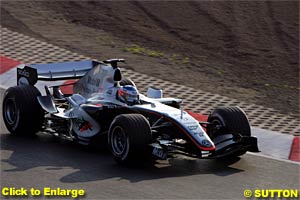 Joining the team last year, the Greek aerodynamicist Nick Tombazis was a surprise signing from Ferrari, albeit he had already left the Italian team rather than being poached by McLaren. Some of the aerodynamic treatments applied on the MP4-19B and MP4-20 are partially reflected in the Ferraris Tombazis worked on. Whitmarsh noted this about Tombazis' influence at the team: "Nick Tombazis has obviously been with us from early last year, and I think he is an extremely experienced aerodynamicist. He is extremely well balanced in that he can recognise the complete package which creates success, and therefore you've got to address all the various technical parameters that go into making a Formula One car.
Joining the team last year, the Greek aerodynamicist Nick Tombazis was a surprise signing from Ferrari, albeit he had already left the Italian team rather than being poached by McLaren. Some of the aerodynamic treatments applied on the MP4-19B and MP4-20 are partially reflected in the Ferraris Tombazis worked on. Whitmarsh noted this about Tombazis' influence at the team: "Nick Tombazis has obviously been with us from early last year, and I think he is an extremely experienced aerodynamicist. He is extremely well balanced in that he can recognise the complete package which creates success, and therefore you've got to address all the various technical parameters that go into making a Formula One car.
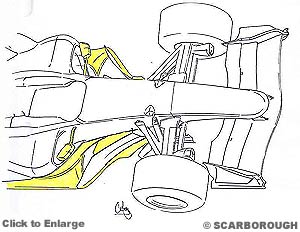 Above and ahead of the sidepods are newly positioned mirrors; while the first purpose of these is of course to provide the driver with a rear view, the shell and mountings can be modified to provide some limited aerodynamic effect. The wide spaced mirrors and horizontal mounts probably provide a straightening effect to the air rushing over the top of the sidepods.
Above and ahead of the sidepods are newly positioned mirrors; while the first purpose of these is of course to provide the driver with a rear view, the shell and mountings can be modified to provide some limited aerodynamic effect. The wide spaced mirrors and horizontal mounts probably provide a straightening effect to the air rushing over the top of the sidepods.
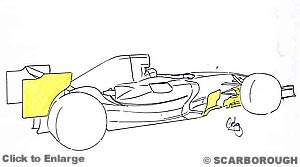 Having not run one last year, the new car appears with a shelf wing ahead of the rear wheels, straightening the flow for the newly positioned rear wing. McLaren have opted to take the wings loads through the endplates, rather than adopting a strut as with BAR or Toyota. Despite this the lower beam is heavily curved, with a distinctive boomerang shape; the beam's shape attempts to put the wing in best possible proximity to the lowered diffuser channels. The endplates themselves follow a more aesthetically pleasing shape, by only extending forward the upper section to meet the forward placed wing. Another part expected but not seen on the new car is a mid wing placed on the roll structure, which would have improved the flow to the rear wing.
Having not run one last year, the new car appears with a shelf wing ahead of the rear wheels, straightening the flow for the newly positioned rear wing. McLaren have opted to take the wings loads through the endplates, rather than adopting a strut as with BAR or Toyota. Despite this the lower beam is heavily curved, with a distinctive boomerang shape; the beam's shape attempts to put the wing in best possible proximity to the lowered diffuser channels. The endplates themselves follow a more aesthetically pleasing shape, by only extending forward the upper section to meet the forward placed wing. Another part expected but not seen on the new car is a mid wing placed on the roll structure, which would have improved the flow to the rear wing.
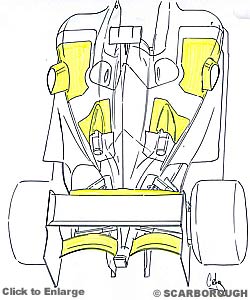 With problems from its introduction through to the midseason B spec, the Mercedes engine was a great disappointment last year. However the unit raced from then on returned the team to reliability and respectable power outputs. Mercedes-Ilmor's spell in the doldrums was perhaps seen as a management or organisation problem more than a technical one, often pinpointed to the untimely death of Paul Morgan in a plane crash, which was then followed by increased input from Mercedes in Stuttgart. Ron Dennis put this right by initially placing his right hand man Whitmarsh in charge, and then more recently putting Kaellenius in control.
With problems from its introduction through to the midseason B spec, the Mercedes engine was a great disappointment last year. However the unit raced from then on returned the team to reliability and respectable power outputs. Mercedes-Ilmor's spell in the doldrums was perhaps seen as a management or organisation problem more than a technical one, often pinpointed to the untimely death of Paul Morgan in a plane crash, which was then followed by increased input from Mercedes in Stuttgart. Ron Dennis put this right by initially placing his right hand man Whitmarsh in charge, and then more recently putting Kaellenius in control.
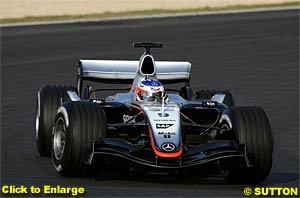 One weak spot which caused McLaren problems on both the MP4-18 and MP4-19A was the integration of the engine into the chassis and gearbox. Again progress has been made under Whitmarsh's management: "the engine interface and integration was very much penned when I spent a lot of my time in the engine company, and so I think there's better harmony and better integration between engine and chassis than we've ever had." Mated to the engine is a new gearbox; Whitmarsh would not be drawn on what material the casing was made in, noting "you'll see in due course. It's one of those things we keep undercover as much we can. The gearbox is different from last year."
One weak spot which caused McLaren problems on both the MP4-18 and MP4-19A was the integration of the engine into the chassis and gearbox. Again progress has been made under Whitmarsh's management: "the engine interface and integration was very much penned when I spent a lot of my time in the engine company, and so I think there's better harmony and better integration between engine and chassis than we've ever had." Mated to the engine is a new gearbox; Whitmarsh would not be drawn on what material the casing was made in, noting "you'll see in due course. It's one of those things we keep undercover as much we can. The gearbox is different from last year."
|
Contact the Author Contact the Editor |
Please Contact Us for permission to republish this or any other material from Atlas F1.
|
Volume 11, Issue 4
Articles
Technical Analysis: McLaren MP4-20
Interview with Ryan Briscoe
Regular Columns
The F1 Trivia Quiz
Bookworm Critique
On the Road
Elsewhere in Racing
The Weekly Grapevine
> Homepage |